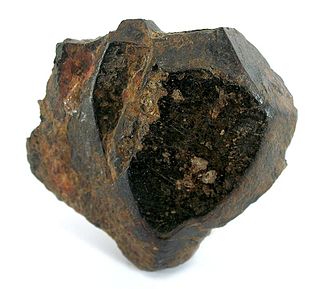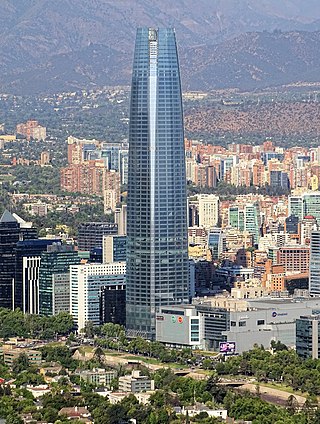Related Research Articles

Sapphire is a precious gemstone, a variety of the mineral corundum, consisting of aluminium oxide (α-Al2O3) with trace amounts of elements such as iron, titanium, cobalt, lead, chromium, vanadium, magnesium, boron, and silicon. The name sapphire is derived via the Latin sapphirus from the Greek sappheiros (σάπφειρος), which referred to lapis lazuli. It is typically blue, but natural "fancy" sapphires also occur in yellow, purple, orange, and green colors; "parti sapphires" show two or more colors. Red corundum stones also occur, but are called rubies rather than sapphires. Pink-colored corundum may be classified either as ruby or sapphire depending on locale. Commonly, natural sapphires are cut and polished into gemstones and worn in jewelry. They also may be created synthetically in laboratories for industrial or decorative purposes in large crystal boules. Because of the remarkable hardness of sapphires – 9 on the Mohs scale (the third hardest mineral, after diamond at 10 and moissanite at 9.5) – sapphires are also used in some non-ornamental applications, such as infrared optical components, high-durability windows, wristwatch crystals and movement bearings, and very thin electronic wafers, which are used as the insulating substrates of special-purpose solid-state electronics such as integrated circuits and GaN-based blue LEDs. Sapphire is the birthstone for September and the gem of the 45th anniversary. A sapphire jubilee occurs after 65 years.

Titanium is a chemical element with the symbol Ti and atomic number 22. Found in nature only as an oxide, it can be reduced to produce a lustrous transition metal with a silver color, low density, and high strength, resistant to corrosion in sea water, aqua regia, and chlorine.

Ilmenite is a titanium-iron oxide mineral with the idealized formula FeTiO
3. It is a weakly magnetic black or steel-gray solid. Ilmenite is the most important ore of titanium and the main source of titanium dioxide, which is used in paints, printing inks, fabrics, plastics, paper, sunscreen, food and cosmetics.

Titanium dioxide, also known as titanium(IV) oxide or titania, is the inorganic compound with the chemical formula TiO
2. When used as a pigment, it is called titanium white, Pigment White 6 (PW6), or CI 77891. It is a white solid that is insoluble in water, although mineral forms can appear black. As a pigment, it has a wide range of applications, including paint, sunscreen, and food coloring. When used as a food coloring, it has E number E171. World production in 2014 exceeded 9 million tonnes. It has been estimated that titanium dioxide is used in two-thirds of all pigments, and pigments based on the oxide have been valued at a price of $13.2 billion.
Ferroalloy refers to various alloys of iron with a high proportion of one or more other elements such as manganese (Mn), aluminium (Al), or silicon (Si). They are used in the production of steels and alloys. The alloys impart distinctive qualities to steel and cast iron or serve important functions during production and are, therefore, closely associated with the iron and steel industry, the leading consumer of ferroalloys. The leading producers of ferroalloys in 2014 were China, South Africa, India, Russia and Kazakhstan, which accounted for 84% of the world production. World production of ferroalloys was estimated as 52.8 million tonnes in 2015.

Arteixo is a municipality in the Province of A Coruña, part of the autonomous community of Galicia in northwestern Spain. Its area is 93.76 km2 and its population is 31,005 (2013). Its population density is 317.43 people/km2.
Titanium mining in Africa has been beset by environmental problems due to the polluting nature of processing rutile, a principal titanium ore. Titanium production in Africa includes the following principal countries and companies.

The Costanera Center Torre 2, better known as Gran Torre Santiago, and previously known as Torre Gran Costanera, is a 62-story skyscraper in Santiago, Chile. It is the tallest building in South America, the second tallest building in Latin America and the fifth tallest building in the Southern Hemisphere. The tower was designed by Chilean architects Alemparte Barreda & Asociados, the Argentine architect César Pelli and the Canadian company Watt International.

Iluka Resources is an Australian-based resources company, specialising in mineral sands exploration, project development, operations and marketing. Iluka is the largest producer of zircon and titanium dioxide–derived rutile and synthetic rutile globally. Iluka mines heavy mineral sands and separates the concentrate into its individual mineral constituents rutile, ilmenite, and zircon. Some of the ilmenite is then processed into synthetic rutile.
QIT-Fer et Titane is a Canadian mining company located in Quebec. The company operates an ilmenite mine at Lake Tio in northern Quebec, and in southern Quebec operates refining facilities that produce titanium dioxide, pig iron, steel, and other metal products. The company is a wholly owned subsidiary of mining giant Rio Tinto Group.
Richards Bay Minerals (RBM) is a South African mining company. RBM's principal product is titanium dioxide in the form of an 85% pure titanium dioxide slag; the company also produces the higher-purity 95% titanium dioxide product rutile as well as pig iron and zircon.

Chañarcillo is a town and mine in the Atacama Desert of Copiapó Province, Atacama Region, Chile, located near Vallenar and 60 km from Copiapó. It is noted for its silver mining. The town grew after the Chañarcillo silver mine was discovered on May 16, 1832, by Juan Godoy. This event sparkled the Chilean silver rush. It grew in prominence in the second half of the nineteenth century and became important in the Atacama mining industry and one of the most important mines to the Chilean economy. It was connected by railway before 1862. Today the settlement is largely in ruins.

Walfordite is a very rare tellurite mineral that was discovered in Chile in 1999. The mineral is described as orange with orange-yellow streak, and is determined to have a chemical formula of Fe3+,Te6+Te4+3O8 with minor titanium and magnesium substitution resulting in an approximate empirical formula of (Fe3+,Te6+,Ti4+,Mg)(Te4+)3O8.

"Titanium" is a song by French DJ and record producer David Guetta, featuring vocals by Australian singer and songwriter Sia. Taken from Guetta's fifth studio album, Nothing but the Beat, the song was written by Sia, David Guetta, Giorgio Tuinfort and Afrojack. Production was also handled by Guetta, Tuinfort and Afrojack. "Titanium" was initially released for digital download on 8 August 2011, as the first of four promotional singles from the album. It was later released as the album's fourth single in December 2011. The song originally featured the vocals of American recording artist Mary J. Blige, whose version of the song leaked online in July 2011.
The Engebø mine is one of the largest titanium mines in Norway. The mine is located in Sogn og Fjordane. The mine has reserves amounting to 154 million tonnes of ore grading 3.8% titanium.
The Pudozhsky mine is one of the largest titanium mines in Russia. The mine is located in Republic of Karelia. The mine has reserves amounting to 516.7 million tonnes of ore grading 8.1% titanium, 1 million oz of platinum and 2.4 million oz of gold.
The Yugo-Vostochnaya Gremyakha mine is one of the largest titanium mines in Russia. The mine is located in Murmansk Oblast. The mine has reserves amounting to 585.3 million tonnes of ore grading 8.51% titanium.
The Kwale mine is one of the largest titanium mines in Kenya. The mine is located in the Coast Province. The mine has reserves amounting to 140.8 million tonnes of ore grading 6% titanium.
The Ranobe mine is one of the largest titanium mines in Madagascar. The mine is located in Melaky. The mine has reserves amounting to 959 million tonnes of ore grading 5.8% titanium.
The Basibasy mine is one of the largest titanium mines in Madagascar. The mine is located in Atsimo-Andrefana. The mine has reserves amounting to 446 million tonnes of ore grading 5.5% titanium.
References
- 1 2 3 "White Mountain Titanium Corporation" (PDF). nordicmining.com. 2012. Archived from the original (PDF) on 2013-12-22. Retrieved 2013-07-05.